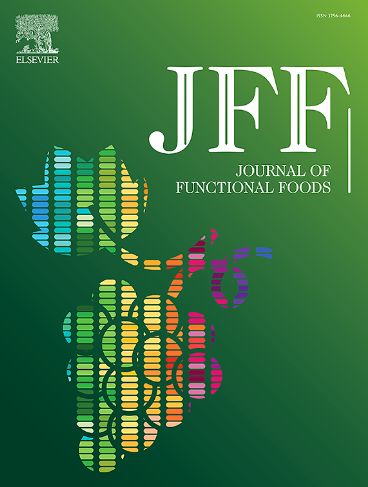A lactoferrin-derived peptide LFDP1 alleviates experimental NEC via blocking ACSL4-LPCAT3 axis
IF 3.8
2区 农林科学
Q2 FOOD SCIENCE & TECHNOLOGY
引用次数: 0
Abstract
This study investigated the anti-necrotizing enterocolitis (NEC) effects of LFDP1, a lactoferrin-derived peptide previously identified as up-regulated in human milk from mothers of preterm infants. Using both in vivo and in vitro models, we evaluated LFDP1's potential to attenuate NEC development. In NEC rat pups, LFDP1 administration significantly reduced the severity of clinical symptoms and pathological features. At the cellular level, LFDP1 restored viability and enhanced migration and proliferation of IEC6 and FHC cells. Molecular analysis revealed that LFDP1 downregulated key NEC process indicators (TLR4, ACSL4, and LPCAT3) while upregulating protective factors (ZO-1 and GPX4). RNA sequencing of LFDP1-treated FHC cells identified 117 differentially expressed mRNAs, with pathway analysis highlighting the involvement of polyunsaturated fatty acid biosynthesis and fatty acid metabolism. Further investigation showed that LFDP1 suppressed ferroptosis by inhibiting the ACSL4-LPCAT3 signaling axis, a finding corroborated in human NEC intestinal samples. Notably, LFDP1 treatment reduced oxidative stress and modulated the expression of ferroptosis-related proteins in vitro. These findings suggest that LFDP1 alleviates experimental NEC by repressing polyunsaturated fatty acid production and inhibiting ferroptosis via the ACSL4-LPCAT3 pathway. Our study not only elucidates a potential mechanism for LFDP1's protective effects but also contributes to the broader understanding of how breast milk composition may protect newborns from diseases like NEC.

乳铁蛋白衍生肽LFDP1通过阻断ACSL4-LPCAT3轴减轻实验性NEC
本研究调查了LFDP1的抗坏死性小肠结肠炎(NEC)作用,LFDP1是一种乳铁蛋白衍生肽,先前发现在早产儿母亲的母乳中上调。使用体内和体外模型,我们评估了LFDP1减弱NEC发展的潜力。在NEC大鼠幼鼠中,给药LFDP1显著降低了临床症状和病理特征的严重程度。在细胞水平上,LFDP1恢复了IEC6和FHC细胞的活力,并增强了它们的迁移和增殖。分子分析显示,LFDP1下调了NEC关键过程指标TLR4、ACSL4和LPCAT3,上调了保护因子ZO-1和GPX4。对lfdp1处理的FHC细胞进行RNA测序,鉴定出117个差异表达的mrna,途径分析显示参与了多不饱和脂肪酸的生物合成和脂肪酸代谢。进一步研究表明,LFDP1通过抑制ACSL4-LPCAT3信号轴抑制铁下垂,这一发现在人类NEC肠道样本中得到证实。值得注意的是,LFDP1处理在体外降低了氧化应激并调节了铁中毒相关蛋白的表达。这些发现表明LFDP1通过ACSL4-LPCAT3途径抑制多不饱和脂肪酸的产生和抑制铁下垂来减轻实验性NEC。我们的研究不仅阐明了LFDP1保护作用的潜在机制,而且有助于更广泛地了解母乳成分如何保护新生儿免受NEC等疾病的侵害。
本文章由计算机程序翻译,如有差异,请以英文原文为准。
求助全文
约1分钟内获得全文
求助全文
来源期刊

Journal of Functional Foods
FOOD SCIENCE & TECHNOLOGY-
CiteScore
9.60
自引率
1.80%
发文量
428
审稿时长
76 days
期刊介绍:
Journal of Functional Foods continues with the same aims and scope, editorial team, submission system and rigorous peer review. We give authors the possibility to publish their top-quality papers in a well-established leading journal in the food and nutrition fields. The Journal will keep its rigorous criteria to screen high impact research addressing relevant scientific topics and performed by sound methodologies.
The Journal of Functional Foods aims to bring together the results of fundamental and applied research into healthy foods and biologically active food ingredients.
The Journal is centered in the specific area at the boundaries among food technology, nutrition and health welcoming papers having a good interdisciplinary approach. The Journal will cover the fields of plant bioactives; dietary fibre, probiotics; functional lipids; bioactive peptides; vitamins, minerals and botanicals and other dietary supplements. Nutritional and technological aspects related to the development of functional foods and beverages are of core interest to the journal. Experimental works dealing with food digestion, bioavailability of food bioactives and on the mechanisms by which foods and their components are able to modulate physiological parameters connected with disease prevention are of particular interest as well as those dealing with personalized nutrition and nutritional needs in pathological subjects.
 求助内容:
求助内容: 应助结果提醒方式:
应助结果提醒方式:


